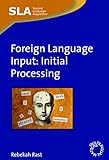Foreign Language Input : Initial Processing / Rebekah Rast.
Material type: TextSeries: Second Language AcquisitionPublisher: Bristol ; Blue Ridge Summit : Multilingual Matters, [2008]Copyright date: ©2008Description: 1 online resource (260 p.)Content type:
TextSeries: Second Language AcquisitionPublisher: Bristol ; Blue Ridge Summit : Multilingual Matters, [2008]Copyright date: ©2008Description: 1 online resource (260 p.)Content type: - 9781847690425
- 9781847690432
- 401/.93 22
- P118.2 .R37 2008
- P118.2 .R37 2008eb
- online - DeGruyter
| Item type | Current library | Call number | URL | Status | Notes | Barcode | |
|---|---|---|---|---|---|---|---|
 eBook
eBook
|
Biblioteca "Angelicum" Pont. Univ. S.Tommaso d'Aquino Nuvola online | online - DeGruyter (Browse shelf(Opens below)) | Online access | Not for loan (Accesso limitato) | Accesso per gli utenti autorizzati / Access for authorized users | (dgr)9781847690432 |
Browsing Biblioteca "Angelicum" Pont. Univ. S.Tommaso d'Aquino shelves, Shelving location: Nuvola online Close shelf browser (Hides shelf browser)

|

|

|

|

|

|

|
||
| online - DeGruyter Biliteracy and Globalization : English Language Education in India / | online - DeGruyter Pathways to Multilingualism : Evolving Perspectives on Immersion Education / | online - DeGruyter Vocabulary Learning Strategies and Foreign Language Acquisition / | online - DeGruyter Foreign Language Input : Initial Processing / | online - DeGruyter TheSociolinguistics of Development in Africa / | online - DeGruyter Teaching English as an International Language : Identity, Resistance and Negotiation / | online - DeGruyter Globally Speaking : Motives for Adopting English Vocabulary in Other Languages / |
Frontmatter -- Contents -- Acknowledgements -- Abbreviations -- Introduction -- Part 1: Theoretical Preliminaries -- Chapter 1. Input and Intake Revisited -- Chapter 2. First Exposure Studies -- Part 2: The Study -- Chapter 3. Polish-French Contrastive Analysis -- Chapter 4. Research Methodology -- Chapter 5. The Adult’s Available Knowledge at First Exposure to an Unknown Language -- Chapter 6. Case Studies: Two Learners with Similar Linguistic Profiles -- Chapter 7. Speech Perception -- Chapter 8. Speech Comprehension -- Chapter 9. Grammatical Analysis -- Chapter 10. Concluding Remarks -- Appendix 1 -- Appendix 2 -- Appendix 3 -- Appendix 4 -- Appendix 5 -- References -- Index
restricted access online access with authorization star
http://purl.org/coar/access_right/c_16ec
Foreign Language Input: Initial Processing presents the most comprehensive study to date of the starting point of second language acquisition. Its focus is on the language input that learners receive and what they actually do with this input. The empirical study detailed in the book follows a methodology in which all of the language input provided to the learners from the moment of first exposure is controlled, recorded and transcribed. This input is then quantitatively compared to the learners’ performance on language tasks administered at various time intervals up to 8 hours after first exposure. This in-depth analysis of the input and the learners’ performance sheds light on questions still unanswered in second language acquisition literature, such as what knowledge is brought to the acquisition process and how learners use this knowledge to process new linguistic information.
Mode of access: Internet via World Wide Web.
In English.
Description based on online resource; title from PDF title page (publisher's Web site, viewed 01. Dez 2022)


